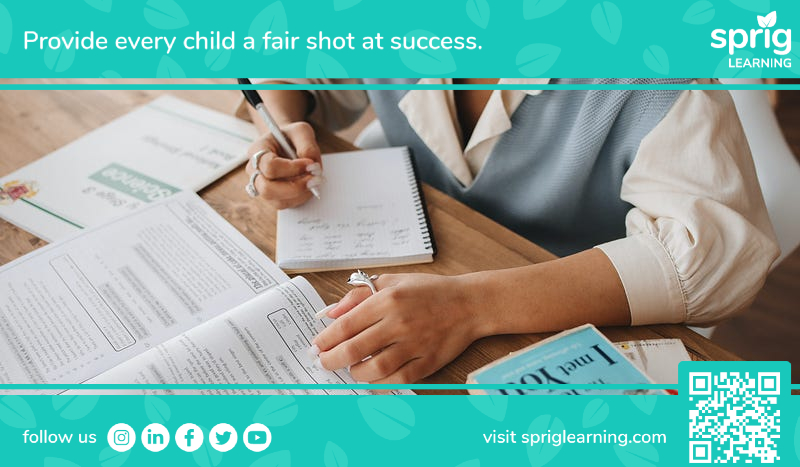This article is the second installment in our series on early literacy statistics. If you haven’t already explored the first edition, it is strongly recommended you do so, as it features 30 figures that shed light on the state of early learning in North America.
In the last edition, while many of the data points were pertaining to early literacy, some of them also covered early childhood education more broadly.
In this article, full concentration is exclusively placed on early literacy, delving deeper into the subject matter.
This article both reinforces key points from the previous edition and introduces new ones.
Without further delay, let’s delve into these 30 compelling statistics of early literacy. Each grouping of similar statistics, is followed by a key insight.

Early Literacy Statistics 1 to 5 (The Critical Window)
The American Institute of Research conducted a study analyzing longitudinal research to discern attributes of reading skill profiles.
It extended previous early reading growth investigations to yield empirical evidence applicable on a national scale.
The results obtained through growth mixture modeling point to five distinct groups of students with specific patterns of early reading development.
They are as follows, and they comprise of the first 5 statistics.
1. High Performers (5 percent of students represent high reading skills at the beginning of kindergarten and maintaining high reading skills).
2. Early Boosters (20 percent of students represent rapid growth between kindergarten and grade 1).
3. Average Learners (52 percent of students represent average initial reading skills and average reading growth).
4. Steady but Slow Learners (20 percent of students represent average initial reading skills but slow reading growth between kindergarten and grade 1).
5. Struggling Learners (3 percent of students represent low initial reading skills and inadequate reading growth during the first 4 years of school).
Key Insight: The time spanning from kindergarten to Grade 1 proves to be exceptionally vital, where early literacy development can either gain momentum, decelerate, or maintain an average pace. Irrespective of prior learning achievements, this period offers an extraordinary opportunity to effect lasting positive changes in a child’s educational journey.
Early Literacy Statistics 6 to 10 (The Grade 1 Turning Point)
6. There is strong evidence indicating that poor readers at the end of grade one have an 88% likelihood of being well below grade level after three additional years of regular instruction.
7. 80% of students that are struggling to read at the end of 1st grade continue to be struggling readers in fourth grade.
8. 90% of children with reading difficulties will achieve grade level in reading if they get help in the Grade 1.
9. 75% of children whose help is delayed to age 9 or later continue to struggle throughout their school years.
10. 74% of children who are behind in third grade will never catch up.
Key insight: Identifying the need for early reading intervention must be done before the conclusion of Grade 1, offering the best chance to equip struggling learners with essential reading skills. In more challenging circumstances, support may still prove beneficial up to Grade 2. However, delaying intervention until Grade 3 drastically diminishes the likelihood of positively altering a young student’s reading trajectory.
Early Literacy Statistics 11 to 13 (Needing Support Frameworks)
A survey encompassing more than 400 educators and administrators nationwide aimed to provide deeper insights into their perspectives on and adoption of Multi-tiered Systems of Support (MTSS).
The findings affirmed that numerous schools are indeed delving into student support frameworks to pinpoint, prioritize, and provide evidence-based interventions for their students. The following numbers stand out:
11. Only 28% of educators say they are far along in implementing a tiered support framework.
12. 52% of respondents rely on spreadsheets to track interventions.
13. Despite 78% of educators saying they believe it’s important to track tiered interventions, only 30% say they are tracking interventions effectively today.
Key Insight: Although there is a clearly identified need for adopting a comprehensive evidence-based tiered support framework (such as the MTSS) for progress monitoring and assessing interventions for all students, widespread adoption is still on the horizon. This indicates an opportunity for their further refinement and enhancement in early literacy.
Early Literacy Statistics 14 to 18 (Lack of Readiness Very Early On )
14. By the age of 2, children who are ready to regularly display greater language comprehension, larger vocabularies, and higher cognitive skills than their peers.
15. Every year 40% of children walk into kindergarten one-to-three years behind grade level.
The Canadian Children’s Literacy Foundation and the Canadian Child Care Federation initiated a national survey targeting early childhood educators (ECEs) to gain insights into the current role of early literacy and learning in Canadian childcare settings.
The objective was to pinpoint potential gaps and opportunities within this context. The survey reached approximately 8,500 members, resulting in 1,108 responses from ECEs who shared their professional experiences. The ensuing statistics offer intriguing perspectives.
16. Only 38% report feeling confident in supporting the early literacy development of the children they work with.
17. Only 35% report feeling confident in identifying a concern with a child’s language development.
18. Fewer than 50% of respondents engage the children they work with in early literacy activities every day, while over 35 % do so once a month or less frequently.
Key Insight: Early literacy disparities emerge in the early stages of a child’s life, primarily due to differing circumstances and opportunities. Consequently, children arrive at kindergarten with varying levels of readiness. This creates a crucial window of opportunity during preschool to address and bridge these disparities. However, early childhood educators often lack the confidence and knowledge required to effectively assess, intervene, and tackle early literacy issues.
Early Literacy Statistics 19 and 20 (Interventions Do Work)
19. Wallace Foundation’s The School Administration Manager Projects, highly recommends that principals spend 50% or more of their time related to instructional work, including assessment that informs teaching and learning.
20. Of the children who receive intervention in kindergarten and continue to require remedial support in first grade, 58% perform at average levels on all reading achievement measures by the end of first, second, and third grades.
Key Insight: Early literacy interventions, especially when applied at the right time,have proven to work. There must be sufficient planning at the administrative level to ensure the implementation of diagnostic assessments and progress monitoring,thereby facilitating targeted support for students.
Early Literacy Statistics 21 to 23 (Addressing the Root Issue)
21. Meta-analysis of close to 75,000 studies revealed that early literacy interventions are effective and instruction in language, phonological awareness, and decoding increases the likelihood of success in reading.
22. For the first time, more than half of the elementary teacher education programs have adopted tenets of the Science of Reading in their curriculum.
23. High-quality tier 1 classroom instruction using an evidence-based, scientifically researched core curriculum meets the needs of about 80 to 90% of students.
Key Insight: Interventions are crucial, but they also emphasize the importance of enhancing core instruction to minimize the need for timely interventions. There’s a shift in the way educators are being trained in reading instruction. Foundational reading skills require explicit teaching and assessment, and evidence already suggests that this approach meets the needs of a significant portion of students in the classroom.
Early Literacy Statistics 24 to 26 (Resources Being The Equity Leveler)
Waterford.org combines learning science, mentorship, and technology to create family and community partnerships that provide access, excellence, and equity in early education for all children. In their article on “Equity vs. Equality in Education,” they present the following key statistics:
24. 60% of the most disadvantaged students come from under-resourced homes or communities.
25. 62% of schools in high-poverty areas report that it is challenging to retain high-quality teachers.
26. While 97% of teachers acknowledge the importance of equity, a significant number remain unsure about the most effective ways to promote it in their classrooms.
Key Insight: Due to limited budgets in their families or schools, students in high-poverty areas often lack equitable resources, making it challenging to provide for their educational needs. Under-resourced communities struggle to retain impactful educators who play a vital role in their students’ lives. It’s not just about retaining teachers; it’s also crucial to empower them with effective resources that benefit all students in their classrooms.
Early Literacy Statistics 27 to 30 (Need for Educator Support)
27. On average, a $1,000 decrease in per-pupil spending leads to a 3.9 percent of a standard deviation reduction in average test scores for math and reading.
The Brookings Institution, a Washington, D.C. nonprofit, is dedicated to conducting comprehensive, nonpartisan research aimed at enhancing policy and governance on local, national, and global scales. A brief from the Brookings Institute’s Center for Universal Education offers insights into a global catalog of educational innovations. It is part of a series of snapshots on Leapfrogging in Education and reveals the following eye-opening statistics:
28. In a survey where Ed-Tech Innovations can select multiple goals, 84% of ed-tech innovations focus on improving students’ skills, whether cognitive or socioemotional, while 23% focus on improving teaching.
29. On supporting the learning process, 67% of Ed-Tech innovations focus on playful, hands-on learning, whereas 25% of them focus on tools to unburden teachers.
30. Literacy is the most common skill targeted by technology innovations, at 61%.
Key Insight: Much emphasis is placed on leveraging technological innovations to address literacy, which is certainly appropriate given the other statistics presented in this article. However, it’s important to note that the majority of these innovations are geared toward helping students directly, rather than supporting educators in teaching these students effectively.
What These Early Literacy Statistics Tell Us
In conclusion, this exploration of early literacy statistics has unveiled several key insights that shed light on the complexities and opportunities surrounding early literacy.
Following these key insights, the following scenario emerges:
There exists a crucial window for timely intervention. Within this timeframe, there is a pivotal juncture at which intervention should be implemented.
Schools are in the initial stages of mastering tiered support systems to identify those in need of intervention.
The root cause of the significant disparities requiring intervention in the first place is the lack of equitable resources even before a child starts school.
While interventions have proven effective, this system must be fine-tuned for incoming students.
Part of this fine-tuning process includes reducing dependency on interventions, which can be achieved via strengthening core instruction.
While plenty of solutions exist to help students directly, teachers should also be equipped with resources to improve early literacy. The availability and use of these resources constitute the key to leveling the playing field.


